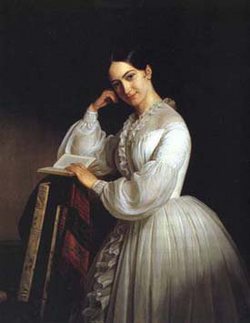Johanne Heiberg (Johanne Luise Heiberg)

Johanne Heiberg was the daughter of a stallholder and innkeeper and his Jewish wife. She showed artistic gifts very early and entered ballet school in 1820. With the help of patrons she was promoted to the rank of an actress and made a successful debut in 1827. From then on she was considered the best leading actress of Danish theatre. In 1831 she married the famous and much older critic and dramatist Johan Ludvig Heiberg, a marriage that raised her position even further and led to her being known as just “Mrs Heiberg”. “The Heibergs” became a Copenhagen concept and their home was a cultural centre. In return the dual position of the Heibergs as the leading lady of the theatre married to its main playwright also aroused much jealousy and accusations of favouritism. Her great popularity with the public did not prevent her making enemies, and her sometimes aggressive and arrogant one-sidedness (revealed in her autobiography) must be blamed for some of this. Her husband’s time as the director of the Royal Theatre 1849-56 ended in an open conflict with her colleagues, and for a short period she even left the theatre. The death of her husband in 1860 and her age caused her retirement as an actress 1864 — still at her height — though she worked as a stage director until 1874.
Johanne Heiberg played about 275 roles. Her exotic beauty combined with culture and elegance secured her position, though she was not the only talented Danish actress of her age. Among her roles must be mentioned some Shakespeare characters (such as Viola in Twelfth Night) and especially in French comedies and dramas. In Danish dramas she shone in Holberg’s and Oehlenschläger’s plays, and especially in her husband’s dramas; her performance in Elves’ Hill (Danish: Elverhøi) was a classic. Her strength was intelligence, controlled passion and wit, but she did not show the same talent for tragedy. She was muse to a whole generation of Danish dramatists, and especially inspired Henrik Hertz to write many of his main female roles for her. She also wrote some few (not especially important) vaudeville acts herself; the most popular is En Søndag paa Amager (“A Sunday at Amager”, 1845). Søren Kierkegaard wrote a tribute to her in 1847, The Crisis and a Crisis in the Life of an Actress. Her autobiography, Et Liv gjenoplevet i Erindringen (“A Life Relived in Memory”, ed. 1891-92) is a major literary work from the Danish Golden Age. It has often been criticised for its subjective descriptions but is still regarded as a pioneering work because of its interest regarding the process of acting.
Though she was closely connected to the romantic tradition, Johanne Heiberg is still regarded as a key figure of Danish drama, of similar status as, for instance, Sarah Siddons in England. Beyond any doubt she contributed to the growing public social and moral perception of Danish actors as artists and cultural personalities rather than simply performers. Her image was featured on the front of the Danish 1997 series 200-krone banknote. It went out of print in 2010. The drama Rain Snakes (Från regnormarnas liv, 1981) by the Swedish author Per-Olov Enquist fictitiously deals with the relationship between Mrs Heiberg and Hans Christian Andersen. The Danish drama 1864 (2014) features Mrs Heiberg as muse and confidant of the Council President Ditlev Gothard Monrad, suggesting that she was instrumental in cheerleading him into a foolhardy war.
Born
- November, 22, 1812
- Copenhagen, Denmark
Died
- December, 21, 1890
- Copenhagen, Denmark0
Cemetery
- Holmens Cemetery
- Copenhagen, Denmark



